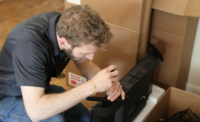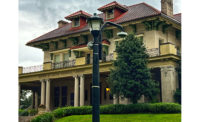Technology at work: Boston Property Upgrades a Sagging Security System
Auto access to the garage is controlled with a proximity card and reader.
After parking, employees flash the same card to access the garage elevator, which only takes them as far as the lobby. A third checkpoint at the lobby elevator only allows access to one floor, where many of the individual tenants have their own access-controlled offices.
All of this is just fine until the system’s software crashes. Then the garage gate is locked in the up position, the garage elevator is wide open and the lobby elevator will take anyone wherever they want to go. The owner’s only option was to add more security guards every time the system crashed, which happened more and more frequently as the system aged.
This was the situation when Boston Properties solicited bids to update their system. The company switched from their original security company to Datawatch Systems Inc., of Bethesda, Md., when Datawatch created a system that saved the customer money by utilizing the existing wiring, took the monitoring from the site to the central station without losing the customer’s confidence and made sure that business in the building hardly missed a beat.
The first hurdle was the approximately 30,000 feet of 20-year-old wiring embedded in the building from the building’s first card reader system, manufactured by Schlage and installed two decades ago. The system utilized RG-6 coaxial cable for data transmission, a technology unique to that system.
“It would have cost two times what it did if they had to pull all that cable� and replace it with new six conductor CAT 5 wiring, said Robert W. Dike, the vice president for sales at Datawatch.
Instead, Datawatch installed HID Multiprox readers and controllers. The data goes from the readers to controllers, eight Multiprox readers feeding into each controller, which then translate signals to Datawatch’s microprocessor, a DW-1 panel.
Routing information to the Datawatch central station was the system’s second major makeover.
Datawatch solved the problem by linking the system to the Internet. By logging on to a secure web site, on site monitors can program new cards, de-program old cards as employees leave, run short history reports of who has entered and left a particular room and follow a particular card’s path through the building.
“They still wanted some hands on. With the ability for the client to go on the Internet, we didn’t pull everything away. They felt more comfortable,� Dike said.
But the central station is always there as a backup, Dike said.
Looking for a reprint of this article?
From high-res PDFs to custom plaques, order your copy today!








